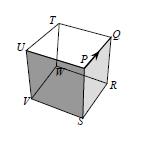Skip over navigation

At Q the ant can choose first to go left to T, then right to W.
Otherwise, at Q it can go right to R and then left to W.
W is the corner diagonally opposite to P and is reached by either route after three edges (and no fewer).
So after exactly three more edges, the ant must reach the corner opposite W, that is, P.
So the ant will return to P after travelling along 6 edges.


Or search by topic
Number and algebra
Geometry and measure
Probability and statistics
Working mathematically
Advanced mathematics
For younger learners
Crawl Around the Cube
Age 11 to 14
ShortChallenge Level 





- Problem
- Solutions

At Q the ant can choose first to go left to T, then right to W.
Otherwise, at Q it can go right to R and then left to W.
W is the corner diagonally opposite to P and is reached by either route after three edges (and no fewer).
So after exactly three more edges, the ant must reach the corner opposite W, that is, P.
So the ant will return to P after travelling along 6 edges.
This problem is taken from the UKMT Mathematical Challenges.
You can find more short problems, arranged by curriculum topic, in our short problems collection.
You may also like
Consecutive Numbers
An investigation involving adding and subtracting sets of consecutive numbers. Lots to find out, lots to explore.
Days and Dates
Investigate how you can work out what day of the week your birthday will be on next year, and the year after...

